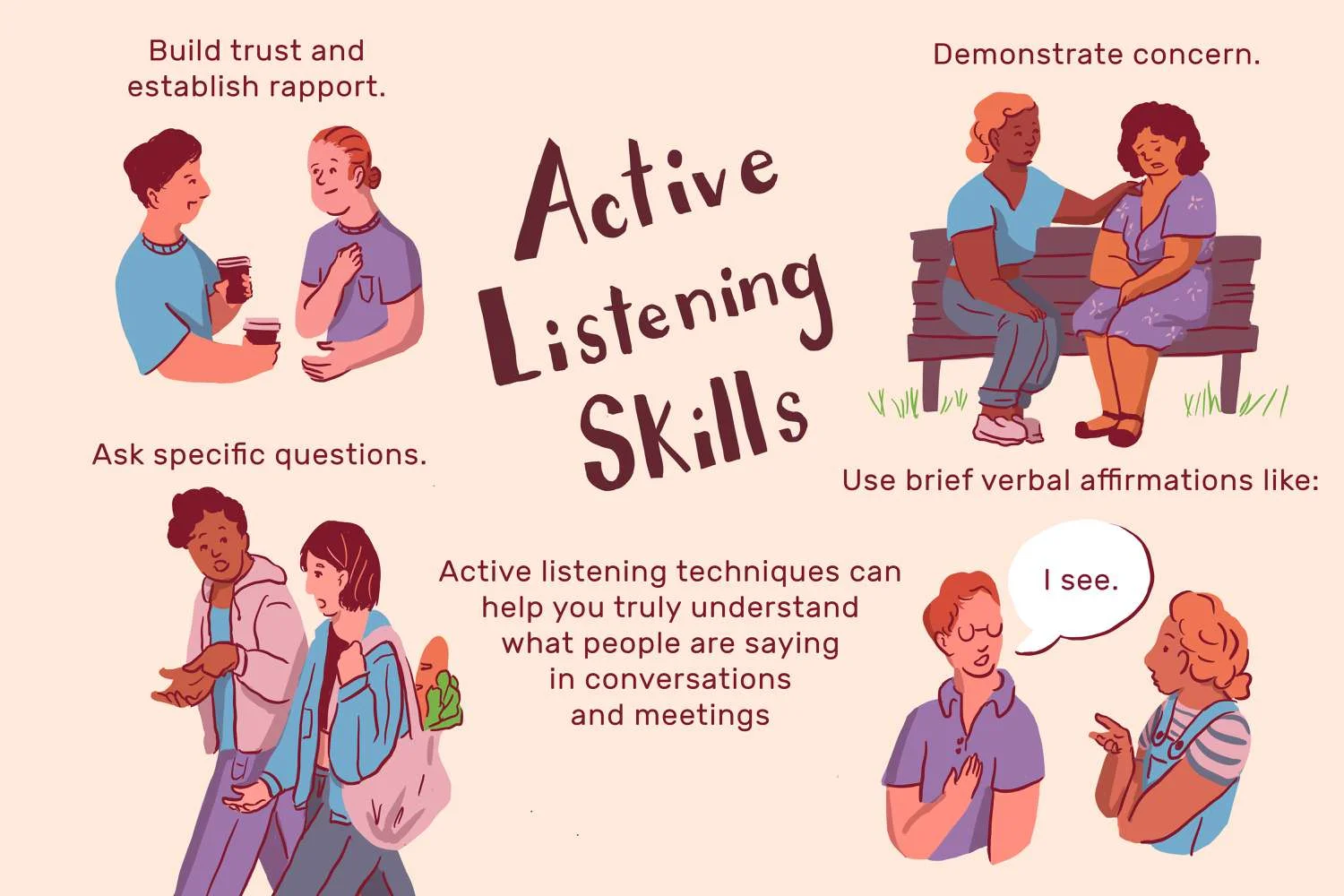Key Takeaways
- Being Fully Present: Concentrate on the person speaking and show respect by eliminating distractions.
- Non-Verbal Cues: Observe body language and facial expressions to get a deeper understanding of what is being said.
- Good Eye Contact: Establish trust with natural eye contact.
- Open-Ended Questions: Ask questions that require more detailed answers so as to encourage further conversation.
- Reflecting: Summarize or paraphrase what has been said in order to ensure comprehension.
- Patience: Allow speakers to finish their thoughts without interrupting them.
- Withholding Judgment: Create safe spaces for honesty by listening openly.
What is Active Listening?
Active listening is a communication technique where the listener has to fully concentrate, understand, respond, and retain what they have heard. In contrast with passive listening, whereby you only hear words, in active listening, there is involvement and interaction between the speaker and listener, thus ensuring that the message received is accurate.
This skill is very vital in building strong relationships, both personal and professional because it promotes trust and reduces misunderstandings while enhancing mutual respect.
7 Techniques of Active Listening
Be Completely Present
Complete presence means giving someone all your attention; this, therefore, requires one not only to listen but also to see the speaker. It entails switching off anything which may distract like phones, among other conversations, as well as environmental noises around us.
By doing so, we indicate our respect towards them through showing genuine interest in whatever they have got say, hence enabling a better understanding of what was communicated across also making people talk freely without any reservations or secrets kept from each other.
Watch Nonverbal Cues
Often beyond words alone are non-verbal cues such as body language, facial expressions, and gestures that can tell more. These signals help us understand better the emotions or intentions behind what is being said by a person during communication.
Some examples include folded arms, which may indicate defensiveness, while smiles show openness; therefore, it’s good to pay attention to these signs because they enable one to respond with empathy and appropriateness.

Maintain Good Eye Contact
In active listening, it’s important to maintain good eye contact throughout the conversation. This tells them that you’re interested in what they’re saying and also helps build connection between two people talking, but should not be done excessively where one starts staring at other, making uncomfortable.
But rather keep looking into each other’s eyes naturally for trust to be enhanced hence improving overall interaction among individuals involved.
Ask Open-Ended Questions
Questions that require more than just yes or no answers should be asked during conversations so as to allow speakers to give their ideas fully without limitations. Closed-ended questions do not encourage deep conversations like open-ended ones do because someone can answer “yes” or “no” without explaining further.
Thereby leaving out some vital information concerning topic discussed, leading only surface knowledge about it.
Mirror What You Hear
This involves paraphrasing or summarizing back what has been said by another person in order for them to know if got a right idea’. It may involve repeating key points made earlier on during an interview with someone else who could have missed those parts, thus showing ability listen carefully while giving chance speaker clarify anything not understood.
Be Patient
It is important to be patient when you are actively listening. Wait for the speaker to finish their statement without cutting them off or rushing them. This shows that you respect their opinion and provides them with an opportunity to convey their message clearly.
Even if there are breaks in speech or moments of silence, do not attempt to fill them. Occasionally, these pauses allow the person speaking time to gather their thoughts and continue the conversation in a meaningful way.
Suspend Judgement
To withhold judgment means listening without forming an immediate opinion or jumping to conclusions. It implies being open-minded and sympathetic, letting someone share their point of view without feeling afraid of criticism.
By putting aside your judgments, you create an atmosphere where people can talk honestly with one another — this builds trust among individuals who might not otherwise communicate well.
Active Listening Examples
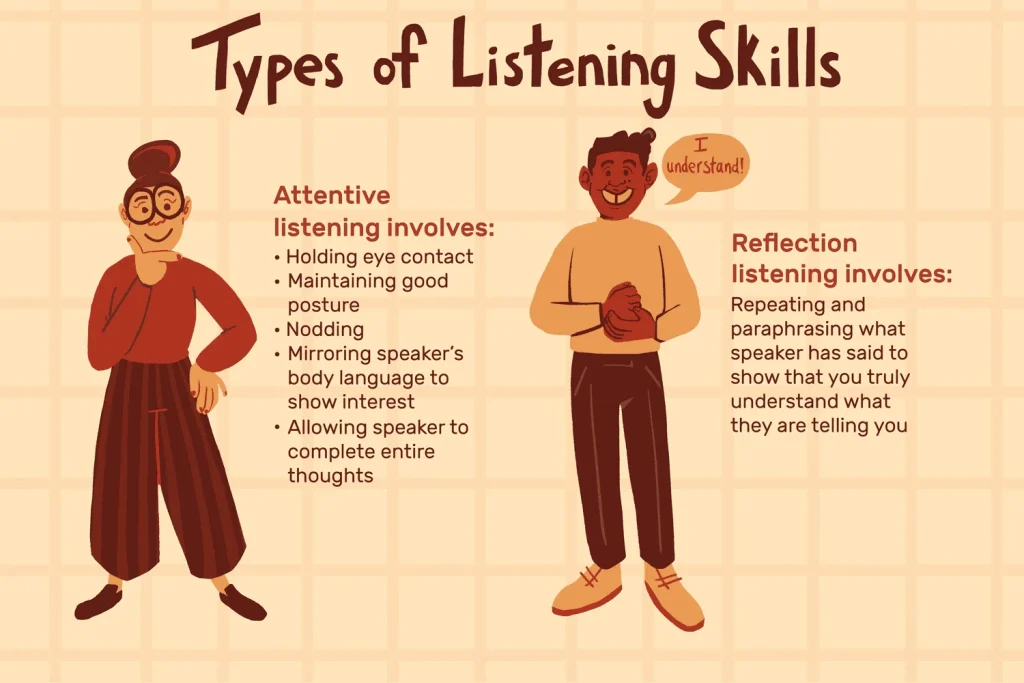
There are many different situations where active listening can be used as a tool for improving understanding through communication. For example, at work, during team meetings, someone could nod their head while taking notes and asking questions that clarify what was said by others so they know if they got everything right.
In personal relationships, it might involve mirroring feelings back, such as saying, “it sounds like you’re really mad about what happened.”These examples show how active listening can help us understand each other better, which ultimately strengthens our bond with one another.
Why Is Active Listening Important?
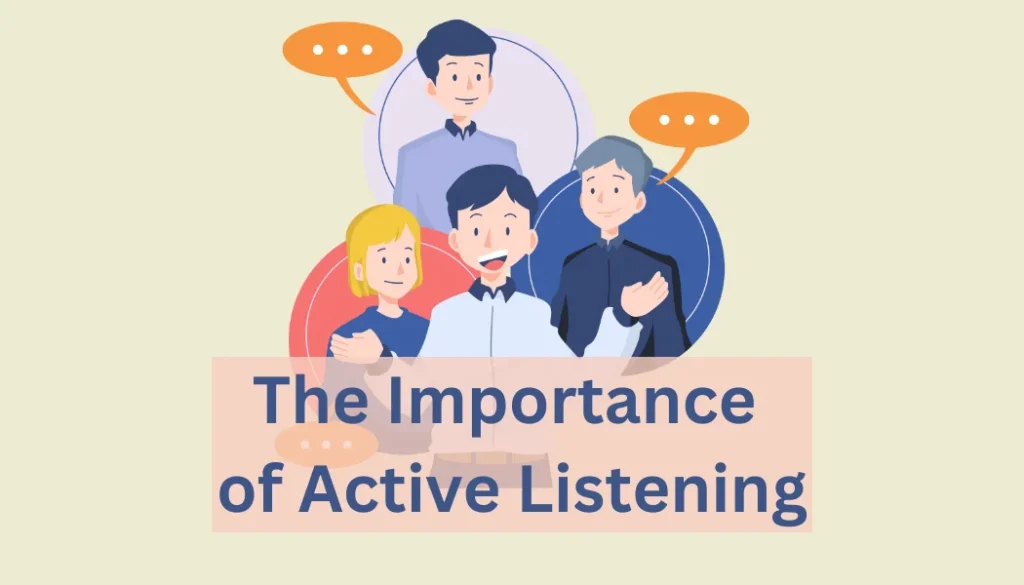
In Relationships
Active hearing plays a critical role in establishing and maintaining healthy relationships. By truly paying attention to your spouse’s words, you validate his/her emotions, thus fostering a deeper emotional connection.
It also facilitaes effective conflict resolution since both parties feel heard & understood equally. Additionally, it prevents misconceptions & misinterpretations, which often lead to problems between two people who love each other dearly.
At Work
In the workplace, active listening is essential for successful collaboration and teamwork. When employees know that they are being listened to, it boosts morale, thereby increasing productivity levels within that particular organization.
Furthermore, active hearing can help us see things from diverse angles, hence improving problem-solving skills among employees. It also enhances leadership qualities because, through active listening, a leader is able to make informed decisions while at the same time building strong working relationships with his/her subordinates.
During Social Situations
Socially speaking, active listening makes conversations more interesting and meaningful. It also enables individuals to establish trust with others thus making it easier for them to make new friends as well as strengthen existing friendships.
Active hearing during social events portrays respect & concern towards other people, thereby making one be seen as approachable & likeable by many. Moreover, it enables us appreciate different opinions, which in turn promotes empathy & tolerance among people living in this world.
Press Play for Advice on Active Listening
For a more engaging learning experience, you can listen to podcasts or watch videos that offer insights into active listening. Multimedia resources of this nature usually contain real life situations plus practical exercises aimed at sharpening your active listening abilities.
By incorporating such multimedia materials into your studies, you will gain better understanding of what active hearing entails and how best it can be applied whenever appropriate.
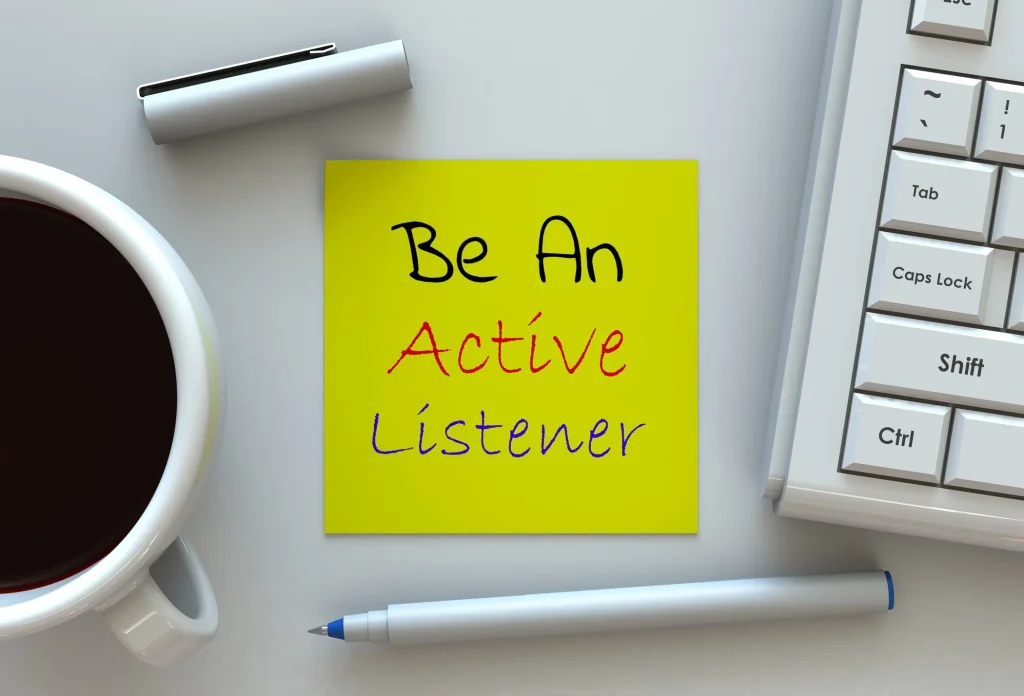
Ways To Improve Active Listening
- Be Mindful: Stay fully present in the moment by eliminating distractions and refocusing your attention on the speaker whenever you notice yourself drifting off. Regular mindfulness practices like meditation can improve concentration and listening skills.
- Boost Emotional Intelligence: To increase emotional intelligence, try to understand your emotions and control them, as well as comprehend others’ emotions and influence them. Reflect on how you respond emotionally to things and practice self-regulation in discussions.
- Restate; Sum it up: Paraphrase what the speaker said using different words and summarize the main points of the conversation to show that you are actively listening. This will also create an opportunity for them to clear any misconceptions they may have had.
- Show Interest without Talking: Use body language such as nodding, smiling when appropriate, maintaining eye contact, or having a facial expression that reflects their feelings while speaking. Open up physically so as to encourage communication from them.
5 Major Tips on Active Listening
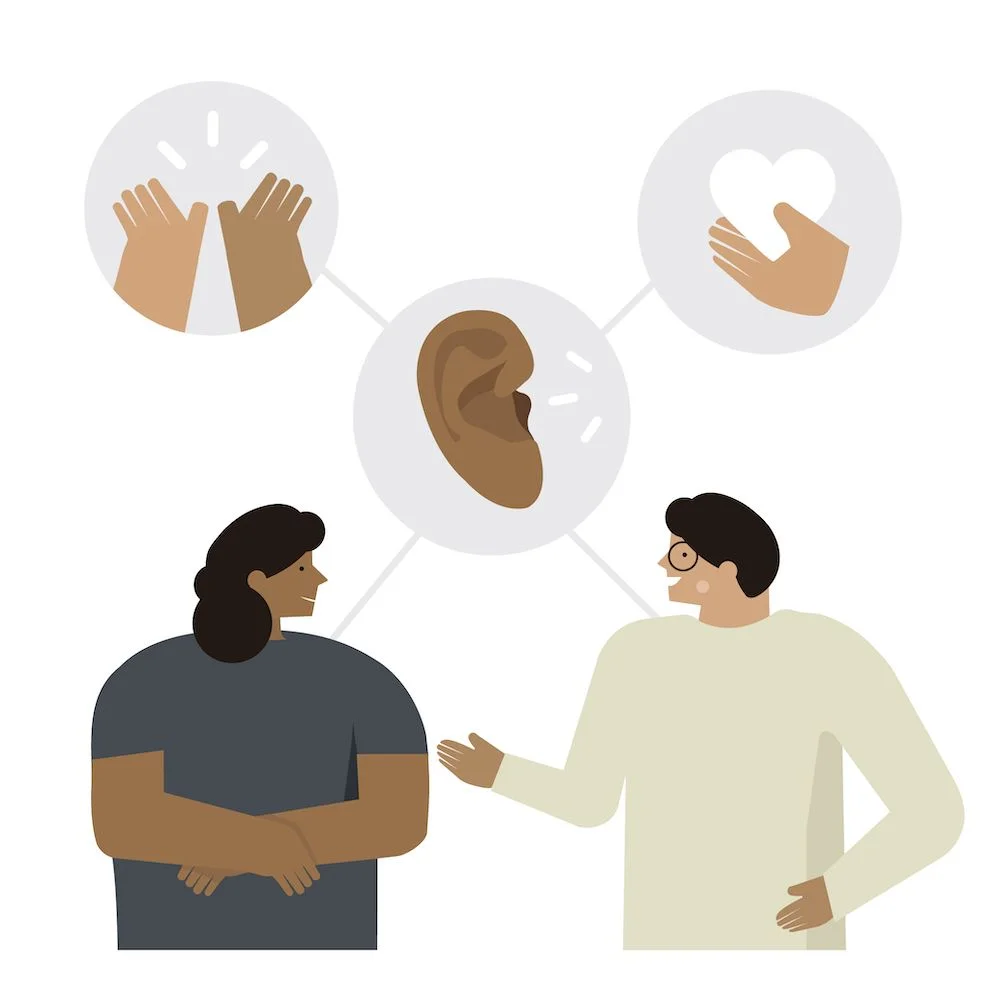
Eliminate Distractions
Make sure there are no distractions while listening by creating a listening-friendly environment; put off your phone, close unnecessary tabs on your computer, and find a quiet place where the concentration is high, thus focusing entirely on what they’re saying.
Express Involvement
Body language can be used to show enthusiasm or encourage involvement or interest in the ongoing conversation by occasionally nodding, smiling, or even having facial expressions that prove awareness of what’s being discussed.
Lean slightly towards the speaker(s) while they talk this shows attentiveness.
Avoid Interruptions
Don’t cut someone short by finishing their sentence before they do it themselves. Give them time to complete their thought before responding back; this way, you’ll respect their opinion and allow them express themselves fully, which might even change yours too.
Ask questions for clarity
When something is not clear, ask further questions about it so that one can get more information concerning the topic under discussion, e.g., Can you explain further?, What did you mean by…? etc.; besides clearing up any misunderstanding, these will also indicate active participation in conversation.
Put Yourself in Their Shoes
Try and see things from the speaker’s point of view by reflecting on their words and emotions, e.g., It sounds as if you’re feeling…; I can see why one might think that… etc.; this creates a stronger bond between both parties since they feel understood better.
Remember
Active listening must be practiced continuously over time to become skilled at it since people don’t just hear words but also understand what is being communicated through emotions. By using these methods regularly during daily interactions with others, we can improve communication skills and build more meaningful relationships because active listening requires being fully present, empathetic, and open-minded.
Conclusion
Active hearing is a key skill to good communication, which builds stronger relationships and promotes comprehension at work and home. One can become better at listening by being completely in the moment, paying attention to body language, keeping eye contact, asking open-ended queries.
Rephrasing what they have heard to show they understand correctly, waiting for the speaker to finish their thought before responding or moving on ourselves and not judging. You should try doing these things often because they will help you communicate better while also making your conversations more trustworthy and empathetic.
Faqs
What is the difference between passive and active listening?
Active listening is when one engages with the speaker, while in passive only hears without paying full attention or understanding what was said.
How do you practice active listening in a noisy place?
Find somewhere quiet or request them to repeat important points; Watch for non-verbal cues and try maintain eye contact as much as possible.
Will my relationships get better if I become an active listener?
Yes, because through it, trust will be built, hence reducing misunderstandings, which makes emotional connection stronger, thus creating good rapport.
Can someone be an active listener even when communicating online?
Definitely yes! This can be achieved by giving undivided attention, asking questions that clear doubts & responding back reflectively.
What hinders people from actively listening most time?
Examples of barriers include pre-judgments, feelings triggered by certain statements made, or showing no interest at all, among others, so knowing them helps us work towards better hearing abilities.

Russell F. Jones, holding a Master in psychology from the University of Florida. He writes for Smart Parent Solutions, offering practical advice on parenting and child development. His engaging content helps parents navigate family life with confidence and ease. Russell enjoys sharing his knowledge and spending quality time with his family.
